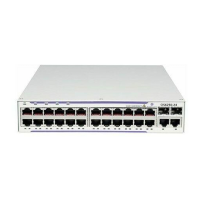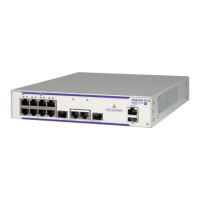System Management
7210 SAS D, E, K OS Basic System Configuration Guide Page 217
Configuration Guidelines and Restrictions
The 7210 SAS supports management of the 1830 VWM CWDM/DWDM clip-on device,
inventory management and displays the clip-on device details such as part numbers, clip-on type,
manufacturing dates, firmware revision, status of alarms It also supports provisioning of the
modules that can be inserted into the slot available on the 1830 device. The following are the
configuration and restrictions guidelines for support of 1830 VWM feature:
• The shelf-ID on the rotary dial must be set to a digit between 1-7. Digits higher than 7 are
not supported by 7210 SAS devices.
• The 1830 VWM clip-on device is connected to a master-shelf (Example: 7210 SAS
devices). Each of the clip-on devices are identified using the shelf ID set using the rotary
dial provided on the device. To aid inventory management, the user must configure the
vwm-shelf-id of the clip-on device attached to the USB interface or the OMC interface.
The vwm-shelf-id must match the shelf ID set using the rotary dial on the clip-on device.
The 7210 SAS uses the configured vwm-shelf-id to communicate with the clip-on device.
If these shelf IDs do not match, 7210 SAS cannot interact with the other devices and does
not provide any information about the device. The 7210 SAS cannot detect a mismatch
between the configured vwm-shelf-id and the shelf ID set on the rotary dial.
• 7210 SAS provides a show command to display the alarm status information provided by
the clip-on device.
• 7210 SAS prints an error log if unsupported devices are plugged into the USB port. Only
approved USB mass storage device and optical clip-on devices need to be recognized as
valid devices. All other devices are unsupported and results in an error log being printed.
A shelf created by the user is operationally down when an unrecognized device is plugged
into the USB port.
• Only a single 1830 CWDM or DWDM device can be managed using the USB interface.
• The management capabilities available through USB and OMC port are similar.
• The first 1830 DWDM device that is connected to a 7210 node using the OMC port or the
USB port must be equipped with active DWDM controllers, while passive DWDM
controllers can be used in the other chassis connected to the first device in a stacked
configuration. In other words, the first 1830 DWDM device that is connected to the OMC
port or the USB port of the 7210 node cannot be a passive 1830 DWDM device, while
subsequent chassis in the stacked configuration can be equipped with passive DWDM
controllers. For more information on stacking configuration please use the 1830 VWM
product manuals.
• The number of DWDM or CWDM devices in a stacked configuration supported when the
stack is managed by 7210 is limited. Please contact ALU representative for more
information on the number of units supported.
• In a stacked/cascaded configuration, all 1830 units connected to the 7210 is of a similar
type either ‘ec-cw’ or ‘ec-dw/ec-dwa’. It cannot be a mix of CWDM and DWDM types.
NOTE: 1830 allows for a mix of passive DWDM and active DWDM devices in a stacked

